Dell XPS 15 L502x: Now with Sandy Bridge
by Jarred Walton on April 20, 2011 1:10 AM ESTNo Surprises: Quad-Core Sandy Bridge Is Still Fast
We’ve already looked at the i7-2630QM when we reviewed the ASUS G73SW and previewed the MSI GT680R. The difference here is that we’re not looking at a 15.6” chassis that’s lighter and thinner than the GT680R, and we’re pairing the CPU with a GT 540M instead of a GTX 460M. For applications, the GPU generally won’t matter, but the presence of Optimus Technology will definitely help in several areas: better battery life, and access to Intel’s Quick Sync for video transcoding. We’ll do a quick check of performance with Quick Sync in a moment.
For the charts, we’re sticking mostly with mainstream laptops. We’ve had plenty systems come through our tests in the past year that meet that classification, and you can make your own comparisons using Mobile Bench. For our applications charts, we’ve got quite a few Arrandale systems and a couple Sandy Bright units, with a smattering of GPUs ranging from IGP (HD 3000) up through GTX 460M. Given the pricing, the XPS 15 will mostly be playing in the $1000+ market, and our test system is very close to the price of laptops like the MSI GT680R and ASUS G73SW, so we’ll include the latter to show where the next performance tier lies. At the other end of the performance and pricing scale, we’re also including an AMD Brazos E-350 laptop, the HP dm1z. It’s not at all in competition with the other laptops—from either a price or performance standpoint—but it does offer plenty of battery life in an affordable package and we liked it enough to give it our Silver Editors’ Choice award.
The laptops we’ve chosen to highlight in this review are the Dell XPS L501x and L502x, in black and green, showing how the SNB update compares to the original. The ASUS G73SW is in red, showing where a faster GPU will get you, and the Sandy Bridge i7-2820QM with an SSD is in gold, providing the reverse picture: more CPU performance and a fast storage subsystem, but with a much slower IGP.
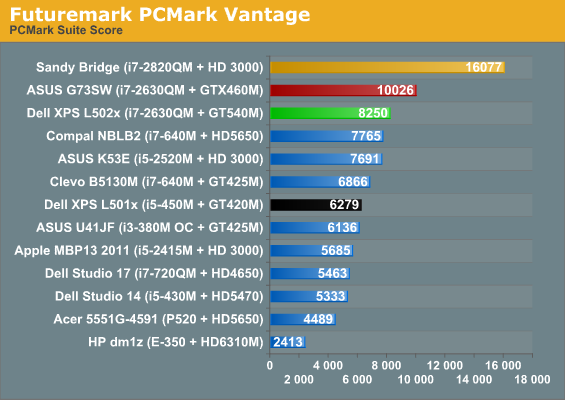

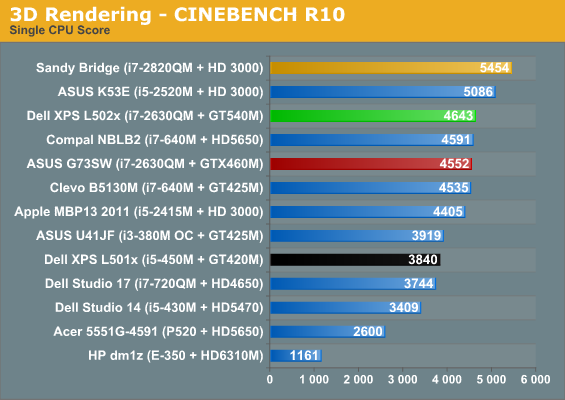
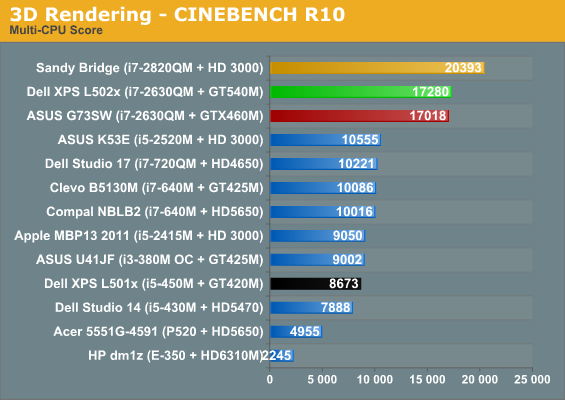
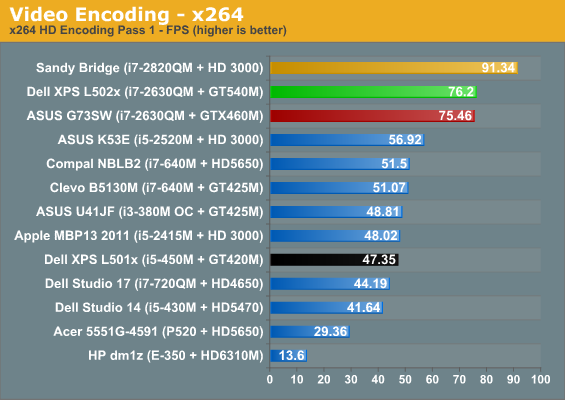
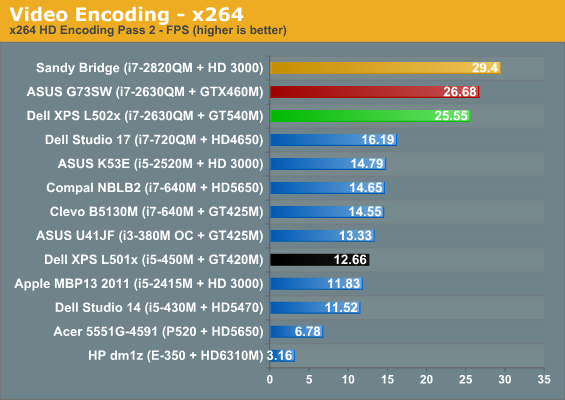
PCMark always likes a fast storage subsystem, and it does give you some idea of how much more responsive a laptop can feel with a good SSD. The Sandy Bridge i7-2820QM ends up nearly twice as fast as the XPS 15 in PCMark Vantage, and 55% faster in the old PCMark05. PCMark also stresses the GPU a bit, which is why the ASUS G73SW ends up around 20% faster than the L502x. Overall, the i7-2820QM with SSD is 37% faster than the L502x and the ASUS G73SW is just 7% faster. The L502x ends up as the third fastest laptop in our application tests, and the only other laptop that manages to squeak by with a lead in the individual results is in the single-core Cinebench test, where the higher single-core Turbo of the K53E/i5-2520M wins out over core count.
Comparing to the original XPS 15 L501x is a bit easier, since all of the main components are at least somewhat faster on the L502x but still similar in specs. The result is performance that’s 20% to 100% faster than the L501x, with the 100% increases coming in the highly threaded Cinebench and Second Pass x264 encoding tests. On average, the L502x is 57% faster than the L501x, though for more mundane office/Internet workloads it’s probably more like 30% faster.
As noted above, we also did some tests of GPU accelerated video transcoding. We used CyberLink’s MediaEspresso and transcoded a 5323 frame 1080p24 video into 720p YouTube format using just the CPU, then with the GT 540M active, and finally using Quick Sync (i.e. HD 3000 active). With Quick Sync, MediaEspresso now has two encoding profiles available, fast and quality, so we tried both. In terms of performance, the CPU alone took 92 seconds, for a final speed of 58FPS. With the GT 540M, performance improved to 69 seconds/77FPS. Finally, Quick Sync with the “Quality” profile took 34 seconds (157FPS), while the “Fast” profile results in the quickest transcoding time, requiring just 25 seconds—or a very impressive speed of 213FPS.
As far as the transcoding quality, subjectively none of the encodes were all that great, showing a clear loss of fidelity from the original 1080p24 source—though that’s expected, considering the final file size was about 10% of the original. I also didn’t notice the issues we saw on CUDA encoding, but the home video I used may not be the best for picking out such details. (We noticed the problems originally on Arcsoft’s Total Media Converter, so it was likely just their implementation of CUDA transcoding rather than a general problem with CUDA, and the latest version might have fixed things.) A final interesting point to mention is that right now, NVIDIA’s Optimus Technology detects MediaEspresso and by default uses the discrete GPU, even though Intel’s Quick Sync is more than twice as fast. Thankfully that you can modify the profile to prefer Intel’s IGP—and on Arrandale’s IGP the dGPU would be preferable—but at present it doesn’t look like NVIDIA’s profiles are smart enough to detect your IGP and determine what path is optimal. That could be a problem down the road when Ivy Bridge and future IGPs continue to improve performance, but hopefully software updates will address the concern.
Okay, that’s enough talk about general application performance. Let’s see how the L502x fares in synthetic graphics performance before we get to the games.

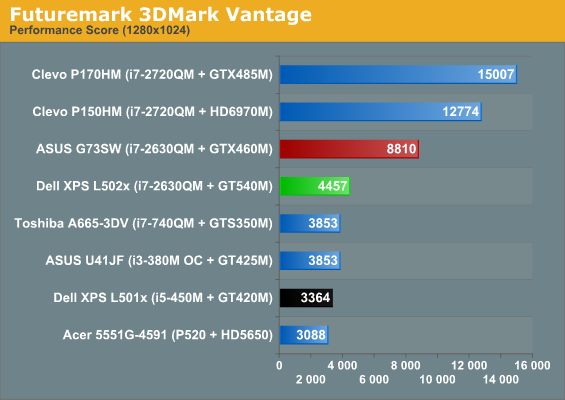

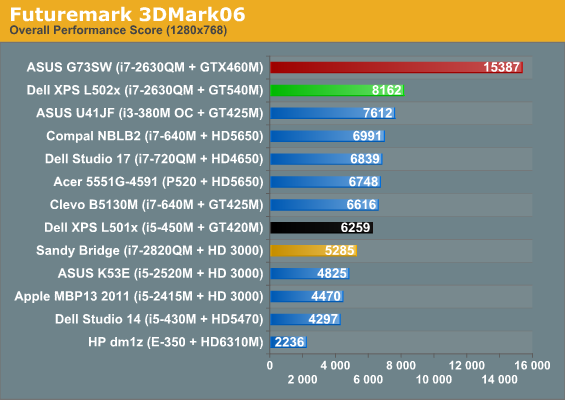
We’re updating our 3DMark charts to focus more on modern workloads, so we’ve added 3DMark 11’s Performance default to our benchmark list, and we’ve included results for 3DMark Vantage’s Performance setting as well—though we don’t have results for all of the other laptops on those charts. We’re also skipping the charts for 3DMark03/05, though you can still see the results in Bench.
Interesting to note is that the 3DMark 11 Performance test appears to be almost entirely GPU limited, as even with a P520 processor the HD 5650 comes out 12% ahead of the GT 425M (and the 540M in turn is 7% faster than the 5650). Depending on how well that comparison holds up, the GTX 460M looks to be around 80% faster than the GT 540M. On paper, the GTX 460M has 101% more computational power and 108% more bandwidth than the 540M, so realizing an 80% performance increase would be about right.
Elsewhere, what we see is a familiar pattern: all of the GT 400M/500M and HD 5650 parts cluster near each other, with the XPS L502x generally coming out on top. The problem is the huge gulf between the GT 540M and the GTX 460M we just mentioned, never mind the top performing mobile GPUs like the HD 6970M and GTX 485M. So once again, this is a decidedly midrange mobile GPU that will struggle with modern games at higher quality settings and higher resolutions—which is what we’ll see next. As far as upgrades from the Arrandale platform, thanks to the increased GPU bandwidth and faster core clocks, plus the quad-core SNB CPU, the new L502x is around 25-35% faster than the old L501x in the 3DMark results. Now let’s find out if that same margin of victory holds in actual games.










76 Comments
View All Comments
softdrinkviking - Wednesday, April 20, 2011 - link
seem to accentuate any flaws or slight color vairiances to me.i definately prefer matte so that i don't have to deal with the glare, but i noticed that anti-glare fliters, or matte finishes tend to exaserbate light bleeding in spots and so on.
i noticed this most on TN screens that have been used for a couple of years and are starting to get a little worn out; the glossy finish seems to hide the deterioration to me.
has anyone else noticed this, or do i have a unique situation/i am going crazy?
JarredWalton - Wednesday, April 20, 2011 - link
The one issue I have with matte is that if you happen to brush against it with an object you can leave a "scar" -- not a scratch, but just a mark in the matte finish. If you have a poorly built laptop where the keyboard or palm rest happens to press against the LCD, that can also cause marking -- on glossy as well, but it's more noticeable on matte. Heck, I have a "scar" on my 30" 3007WFP that happened when I was packing for a move. Yeah, ouch! The old Dell Studio XPS 16 had the other issue, with keyboard marks showing up on the edge-to-edge display cover.Anyway, having seen both the Clevo P150HM/151HM and the XPS 15 panels side by side, I'd definitely take the matte and run that risk.
JNo - Friday, April 29, 2011 - link
Jarred,I have a Dell 2405 FPW with matte finish. Spent around £800 on it back in the day but don't regret it a bit as it's still a contender - rare even now to find 24" with matte IPS that can go portrait and has a USB hub and card readers built in. Anyhoo, I digress... I also got scars on it once or twice and I couldn't for the life of me 'wipe' them away but if you google around you can find solutions...
Amazingly, I found using a clean (try new) white or colourless rubber on the screen and rubbing gently in the direction of the scar worked. Wipe before and after with a lint free micro-fibre cloth and just a teensy bit of water. It literally made the scar disappear and the monitor looks as new again. I sh1t you not - worth a try.
vol7ron - Wednesday, April 20, 2011 - link
posts like this too.Flunk - Sunday, April 24, 2011 - link
I've found quite the opposite. My matte displays seem to hold up much better than the glossy. The glossy ones seem to pick up scratches, marks and smudges very easily and they show horribly. The matte finish tends to disguise the little things.AmdInside - Wednesday, April 20, 2011 - link
I bought the L502x and love it. One great thing about Optimus is that since the Intel graphics is still used for 2D, Intel Quick Sync is possible with this laptop. It is amazing how fast it can convert video for a laptop.I guess my main complaint is that I preferred the previous generation keys better over the newer smaller softer keys. Dell has regular sales on XPS laptops which really brings down the cost of this laptop. I got a fully loaded Dell XPS 15 L502x for around $1300 after taxes. Just love love love the 1080p screen.
Oh, and I personally am not a big fan of super thin laptops. They just don't feel right when they are on my lap. I like my keyboard to be raised a little so the thicker body of the l502x suits me just fine. I wish Dell hadn't dropped the 14" model as I would have bought that if it was still available with Sandy Bridge for portability but the 15" is fine.
therealnickdanger - Wednesday, April 20, 2011 - link
I had a 17" Dell years ago with a 1080p screen and a 7900GT Go. It did OK, but ultimately, I don't think I would ever buy another 1080p laptop without a high end GPU. If the L502X had a higher GPU option, it would be perfect! I would probably order this laptop with the 768p screen and upgrade to the 540 and play games with max settings at native resolution.aneuwahl - Wednesday, April 20, 2011 - link
Hello,there is a puzzling thread on Dell's support forum here
http://en.community.dell.com/support-forums/laptop...
about an unsolved problem regarding the USB3.0 ports. They seem to fail randomly becoming completely inactive till next reboot.
I'm curious if during the test anything like that was noticed.
I've just bought a L702x and I have the same problem. Dell replaced my motherboard (not the USB3.0 daughterboard), but the issue - with reduced occurency - is still there.
JarredWalton - Wednesday, April 20, 2011 - link
Is it possible they're going into a power saving state and not coming out of it? I actually don't have any USB3 devices on hand, so I didn't encounter this, but I should be getting something soon. Let me get back to you....jcannon1018 - Wednesday, April 20, 2011 - link
Supposedly, under all programs there is a folder for the usb 3.0 controller and clicking on it will bring up a settings panel for the controller. On that panel there is a disable power management function, checking apparently resolves the issue of the ports becoming unresponsive. I thought that sandy bridge had native support though?